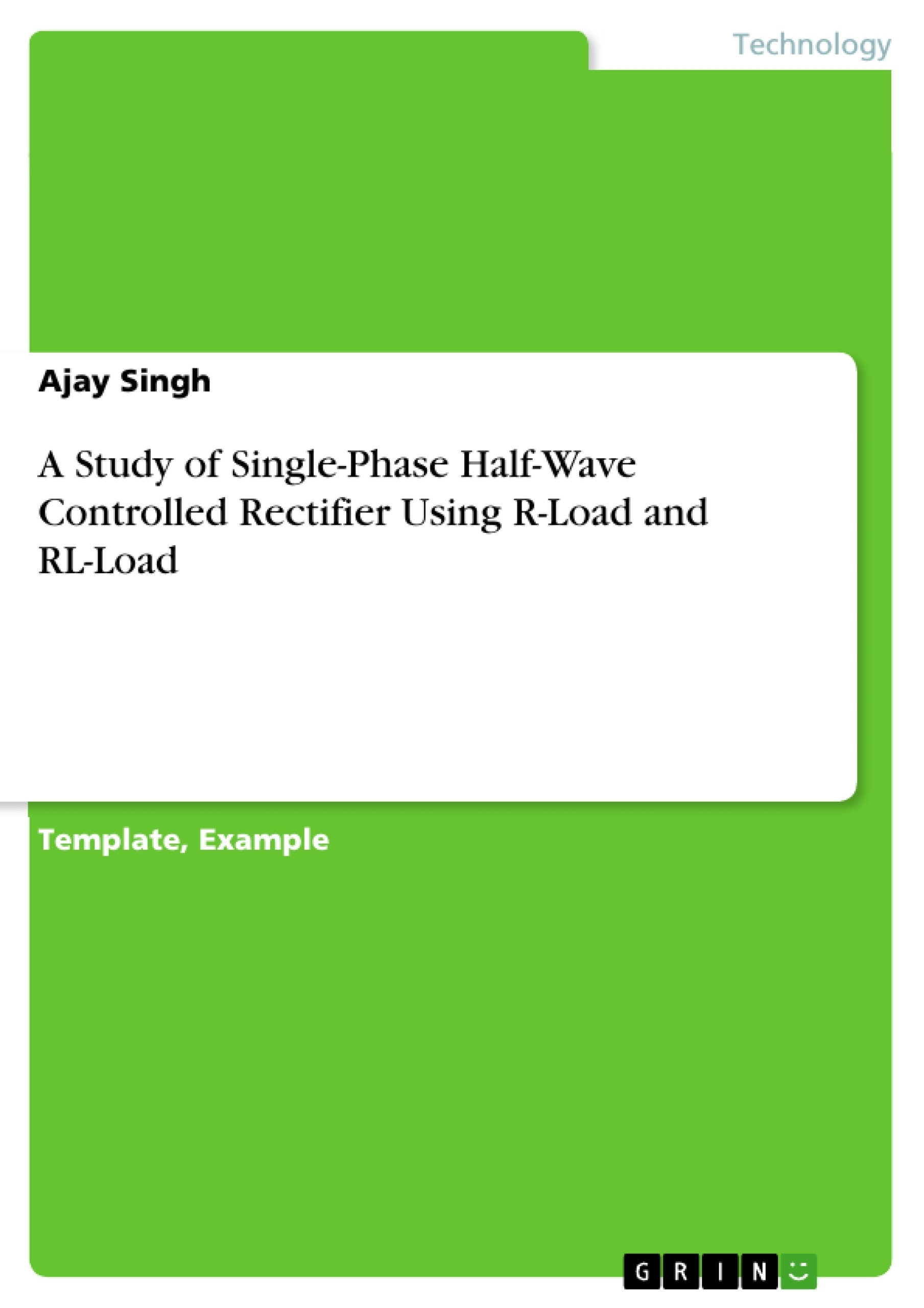The objective of this study is to familiarize with the SCR in controlled rectification with resistive and inductive load.
Included in this paper is a list of the apparatus required and the theory behind the single-phase half-wave controlled rectifier using R-load and as well as using RL-load. An example of a table for recording observations is given as well as pictures making backgroud information clearer.
#LAB 1
STUDY OF SINGLE PHASE HALF WAVE CONTROLLED RECTIFIER USING R - LOAD AND RL - LOAD
OBJECTIVE
To familiarize with the SCR in controlled rectification with resistive (R) and inductive (L) load.
APPRATUS REQUIRED
1. Thyristor Kit
2. Connecting Wires
3. Oscilloscope
4. Multimeter
THEORY
Single-Phase Half-Wave Controlled Rectifier using R - load
The single-phase half-wave controlled rectifier uses a single thyristor with a load and also the output voltage and current waveform as shown in figure 1. In a positive half cycle of source voltage ( = ), thyristor is forward biase
d and when gate current iGis applied to the gate terminal at firing angle α then thyristor strarts to conduct. The output voltage will appear from [illustration not visible in this excerpt] thyristor goes turned OFF. In a negative half cycle,[illustration not visible in this excerpt] thyristor is reverse biased and output voltage is zero during this period. Therefore, by changing the value of firing angle (α) the output voltage can be controlled.
The average output voltage is given by:
illustration not visible in this excerpt
Figure 1 Single Phase half wave controlled rectifier with resistive load
Single-Phase Half-Wave Controlled Rectifier using RL - load
The single-phase half-wave controlled rectifier uses a single thyristor with a RL load and aslo the output voltage and current waveform as shown in figure 2. In a positive half cycle of source voltage ( = ), thyristor is forward biased and when gate current iG is applied to the gate terminal at firing angle α then thyristor starts to conduct. The output voltage will appear from [illustration not visible in this excerpt] thyristor goes turned OFF but current does not decay to zero because of the energy stored in inductor. The negative voltage will appear from [illustration not visible in this excerpt]. The load current decays to zero at [illustration not visible in this excerpt] and value of β depends upon the ratio R/L. During [illustration not visible in this excerpt] to [illustration not visible in this excerpt], the output voltage is zero during this period. The angle β is called extinction angle and [illustration not visible in this excerpt] is called conduction angle.
illustration not visible in this excerpt
Figure 2 Single phase half wave controlled rectifier with resistive-inductive load
OBSERVATION
1. Input Parameter
a. Input voltage ..
b. Frequency ...
c. Cycle time period ...
2. Observation Table
Half wave controlled rectifier with R - load
illustration not visible in this excerpt
Half wave controlled rectifier with RL - load
illustration not visible in this excerpt
Frequently Asked Questions
What is the objective of this lab experiment?
The objective is to familiarize with the SCR (Silicon Controlled Rectifier) in controlled rectification using both resistive (R) and inductive (L) loads.
What apparatus is required for this experiment?
The following apparatus is required: Thyristor Kit, Connecting Wires, Oscilloscope, and Multimeter.
What is a Single-Phase Half-Wave Controlled Rectifier with R-load, and how does it work?
It uses a single thyristor with a resistive load. In the positive half cycle of the source voltage, the thyristor is forward biased. When a gate current is applied at the firing angle α, the thyristor starts conducting, and output voltage appears. During the negative half cycle, the thyristor is reverse biased, resulting in zero output voltage. Changing the firing angle (α) controls the output voltage.
What is the formula for the average output voltage in a Single-Phase Half-Wave Controlled Rectifier with R-load?
The formula for the average output voltage is provided, but the illustration is not visible in this excerpt.
What is a Single-Phase Half-Wave Controlled Rectifier with RL-load, and how does it work?
It uses a single thyristor with an RL (Resistive-Inductive) load. In the positive half cycle of the source voltage, the thyristor is forward biased. When a gate current is applied at the firing angle α, the thyristor starts conducting, and output voltage appears. Even after the thyristor turns OFF, the current doesn't immediately decay to zero because of the energy stored in the inductor, leading to negative voltage. The load current eventually decays to zero at an angle β, which depends on the R/L ratio. The period from [illustration not visible in this excerpt] to [illustration not visible in this excerpt] has zero output voltage. Beta is called extinction angle, and [illustration not visible in this excerpt] is called conduction angle.
What observations need to be recorded during the experiment?
Input parameters such as input voltage, frequency, and cycle time period need to be recorded. Also, observation tables for both Half-Wave Controlled Rectifier with R-load and RL-load need to be filled, but the illustration not visible in this excerpt.
- Citar trabajo
- Ajay Singh (Autor), 2016, A Study of Single-Phase Half-Wave Controlled Rectifier Using R-Load and RL-Load, Múnich, GRIN Verlag, https://www.grin.com/document/376773



